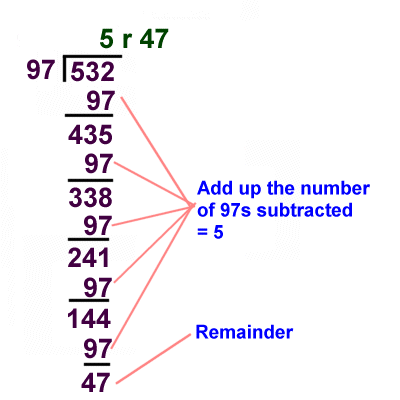

The line is called called a vinculum, which is a Latin word meaning ‘bond or link’. So 12 ÷ 4 is equivalent to writing, where the numerator, 12, is the dividend and the denominator, 4, is the divisor. The writing of a fraction is really another way to write division. Mathematicians almost never use the ÷ symbol for division. Another way to write division in school arithmetic is to use the notation, meaning ‘12 divided by 3’, but sometimes read as We read the statement 12 ÷ 3 as ‘12 divided by 3’. It was first used to signify division in 1659. The division symbol ÷ is known as the obelus. In algebra it is common to not use a symbol for multiplication at all. In some countries a middle dot is used so 3 × 4 is written as 3.4. We read the statement 3 × 4 as ‘3 multiplied by 4’. It was chosen for religious reasons to represent the cross. The × symbol for multiplication has been in use since 1631. Teachers should take care not to use the word ‘sum’ for anything but addition. Finding the ‘sum’ of two or more numbers means to add them together. This is an inaccurate use of the word ‘sum’. Many years ago we were told to ‘do our sums’ and this could apply to any calculation using any of the operations. It is important that we use the vocabulary related to multiplication and division correctly. So the product ofģ and 4 is the multiplication 3 × 4 and is equal to 12. The product of two numbers is the result when they are multiplied. Interestingly, the word widow has the same etymological root, which can be understood in the sense that a widow is a woman forced apart from her husband. It comes from the Latin, dividere meaning ‘to force apart, cleave or distribute’. The word ‘divide’ was used in mathematics from the early 15th century.
The term ‘manyfold’ in English is antiquated but we still use particular instances such as ‘twofold’ or threefold’. The word ‘multiply’ was used in the mathematical sense from the late fourteenth century and comes from the Latin multi meaning ‘many’ and plicare meaning ‘folds’ giving multiplicare - ‘having many folds’, which means ‘many times greater in number’. Looking at where words come from gives us some indication of what they mean. Often it is desirable to emphasise one term more than others when introducing concepts, however a flexibility with terminology is to be aimed for. It is important that children are exposed to a variety of different terms that apply in multiplication and division situations and that the terms are used accurately. For example, we might say that a child is the product of her environment or we insist that children ‘share’ their toys even though we do not always expect them to share equally with everyone. Some of these words are used imprecisely outside of mathematics. Multiplication − multiply, times, product, lots of, groups of, repeated additionĭivision − sharing, divided by, repeated subtraction There is a great deal of vocabulary related to the concepts of multiplication and division. Division with remainder is a fundamental idea in electronic security and cryptography. As such, multiplication provides an early link between arithmetic and geometry.įluency with division is essential in many later topics and division is central to the calculations of ratios, proportions, percentages and slopes. The natural geometric model of multiplication as rectangular area leads to applications in measurement. For example, it is much quicker to calculate 6 × 27 by multiplication than by repeated addition.įluency with multiplication reduces the cognitive load in learning later topics such as division. When there are many collections of the same size, addition is not the most efficient means of calculating the total number of objects. What is the total length of wire that Henry has?ĭivision answers questions such as: 1 How many apples will each friend get if four friends share 12 apples equallyĢ If twenty pens are shared between seven children how many does each child receive, and how many are left over?Īddition is a useful strategy for calculating ‘how many’ when two or more collections of objects are combined.

How many chocolates did Judy have?Ģ Henry has 3 rolls of wire. Multiplication answers questions such as: 1 Judy brought 3 boxes of chocolates. Some division problems arise when we try to break up a quantity into groups of equal size and when we try to undo multiplications. Arrays are a good way to illustrate this. Multiplicative situations arise when finding a total of a number of collections or measurements of equal size. One way of thinking of multiplication is as repeated addition.


 0 kommentar(er)
0 kommentar(er)
